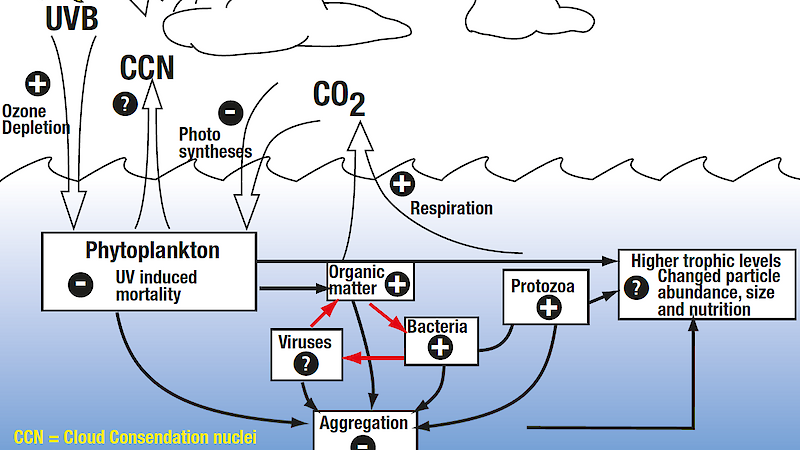Single celled marine plants (phytoplankton) are instrumental in determining global climate. They moderate the global greenhouse effect by absorbing CO2 from the atmosphere and they release sulphur compounds, which when vented to the atmosphere, promote cloud formation and increase global reflectance of the Sun’s rays. Phytoplankton proliferate in Antarctic coastal waters during spring and summer where, directly or indirectly, they support the wealth of marine life for which Antarctica is renown. Single celled animals (protozoa), bacteria and viruses consume most of the energy trapped by phytoplankton (see diagram).
Depletion of stratospheric ozone over Antarctica during spring and summer increases solar ultraviolet-B (UVB, 280–320nm) radiation throughout the period of greatest biological production. There is overwhelming scientific evidence that UVB penetrates to biologically significant depths in the marine environment and is damaging to marine organisms. Previous studies of the effect of UVB have concentrated on phytoplankton. But phytoplankton do not exist in isolation and other microbes, the protozoa, bacteria and viruses, can be directly damaged or killed by solar UVB. Due to the interactions between trophic levels of the microbial community, any UVB-induced impact at one level can alter the entire community. To understand the total effect of UVB, we need to consider both the effects on each species and those on the whole community.
We exposed natural Antarctic microbial communities to ambient sunlight in incubation tanks at Davis station. Responses of the individual species of microbes to UV exposure varied from increased growth to mortality. However, near-surface UVB irradiances caused an overall decline in phytoplankton concentration and biomass. This UVB-induced phytoplankton mortality promoted bacterial activity and these bacteria, possibly together with the material from dead phytoplankton, fuelled growth of protozoa that were UV-tolerant. This study showed that exposure to UVB can caused a complex mosaic of changes in the microbial community. Different species of microbes exhibit differing sensitivity to UVB exposure. The extent of these changes was determined by the direct effect of UVB on the microbial species, and the indirect effect of UVB-induced changes on the microbial community. We concluded that exposure to UVB radiation can change the abundance, size, structure, palatability and nutritional quality of food within the food web. Results indicate that UVB radiation can change the structure and function of the microbial community, reducing the uptake of CO2 by phytoplankton and increasing the CO2 respired by microbes (see figure 1). Thus, ozone depletion is likely to reduce the capacity of Antarctic waters to act as a sink for atmospheric CO2, and exacerbate global climate change due to ‘greenhouse’ warming.
Andrew Davidson
Biology Program,
Australian Antarctic Division

